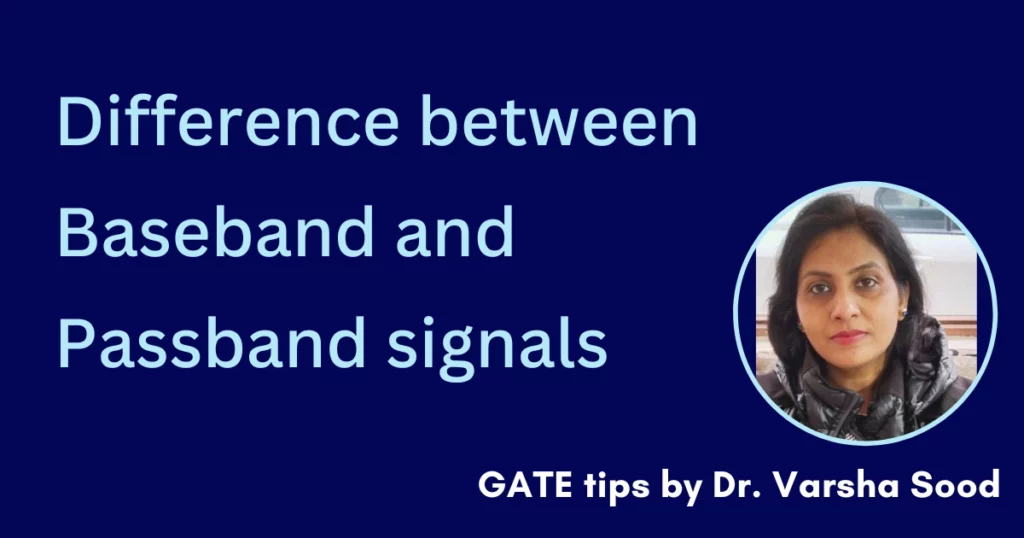In the field of communications, equipped with state of the art technology, the study of signals plays a pivotal role. Whether it is sending or receiving information, use of signals is important.
Understanding the fundamentals concepts is crucial for unlocking the potential of modern communication system.
In this article, we are going to see the difference between “Passband” and ‘Baseband” signal. These two terms serves keystone for understanding that how information is transmitted, modulated and demodulated across various communication mediums.
From radio waves to fiber optics, the distinction between passband and baseband signals forms the base on which our interconnected world operates.
For understanding the difference between Passband and Baseband signal, You can refer the video below.
You can watch a quick YouTube video or read along.
Understanding Baseband Signal
The transmission of signal in its original form i.e. unmodulated form is called as Baseband signal. The message generated from the information source is called as Baseband signal. They are relatively of low frequency.
A baseband signal can be analog or digital. Baseband signals do not require a carrier frequency. Baseband signals can represent both digital and analog information. In the case of digital data, different voltage levels may represent binary digits (0s and 1s).
For analog signals, the voltage variations directly correspond to the variations in the original analog waveform.
Baseband signals are typically used for short range communication and within devices. They are not suitable for long range communication due to the potential signal attenuation and interference.
Baseband signals are found in various applications, including digital communication systems (like Ethernet and USB connections), audio transmission, and control systems.
Its advantages is that there is a simplicity and direct representation of data.
The disadvantage is that it is not suitable for long distance communication due to signal attenuation and interference.
Understanding Passband Signal
The modulated signal is called as Passband signal. The modulated signal is formed by the combination of message signal and carrier signal. These signals are of high frequency.
Passband signal refers to the signal that has been modulated or shifted from its original frequency range(baseband) to a higher frequency range.
The passband signal is characterized by the presence of carrier frequency which is a high-frequency sinusoidal waveform. The carrier frequency serves as a carrier wave onto which the original baseband signal is modulated.
Passband signals are used in various communication systems to overcome the limitations of baseband signals.
Its advantage is that it is used for long distance communication as they are less susceptible to the interference and signal loss compared to baseband signal.
Passband signals are used in a wide range of applications, including radio broadcasting, television transmission, wireless communication, cellular networks, satellite communication, and more.
For the efficient and reliable transmission of information over a various channel , passband signal are used.
The passband signal has its frequency spectrum concentrated around the carrier frequency. They are ideal for communication channels with frequency response equivalent to a band-pass response effect, similar to wireless transmissions.

So, let us conclude with the key differences between passband and baseband signals.
| Sr. No. | Passband Signal | Baseband Signal |
| 1. | Passband refers to filtered signal in which the amplitude and the frequency or phase of the carrier signal is modulated to transmit the bits. | Baseband refers to the original transmission signal generated from the message source with no modulation of high frequency carrier. |
| 2. | Passband signals operate in a higher frequency range. | Baseband operates in low frequency. |
| 3. | Passband signal can be used for long distance communication | Baseband signals are typically used for short range communication . They are not suitable for long range communication due to the potential signal attenuation and interference. |
| 4. | Passband signals undergo modulation. | Baseband signal so not undergo modulation. |
| 5. | The bandwidth of passband signals is broader than that of baseband signals. | The bandwidth of a baseband signal is relatively narrower compared to passband signals. |
| 6. | Ex. AM (Amplitude Modulation) and FM (Frequency Modulation) radio broadcasts, wireless communication signals, television broadcasts | .Ex. Binary digital data (0s and 1s) represented by voltage levels, low-frequency audio signals, control signals within devices. |
Hope, so, the difference between bandpass and passband has been cleared to you.


